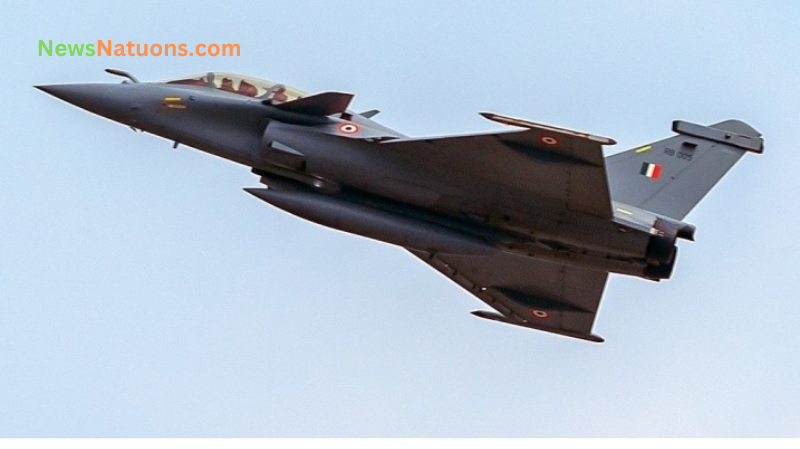In a dramatic shift following its recent military setback, the Indian government has approved a bold initiative to develop an indigenous fifth-generation stealth fighter jet. This announcement comes in the wake of a confrontation with Pakistan, during which India reportedly lost six of its fighter aircraft, including three advanced Rafale jets, bringing significant embarrassment to the Indian Air Force.
According to international news agencies, India’s Ministry of Defence issued an official statement confirming that Defence Minister Rajnath Singh has granted approval for the development of a prototype of the Advanced Medium Combat Aircraft (AMCA). This aircraft is expected to be India’s first true fifth-generation stealth fighter, aimed at elevating the country’s airpower capabilities to match global standards.
Indigenous Development to Be Led by ADA
The responsibility of designing and developing the AMCA has been assigned to the Aeronautical Development Agency (ADA), a government-run entity under the Ministry of Defence. ADA has previously worked on the Tejas Light Combat Aircraft project, although that program faced several delays and challenges.
This new endeavor is expected to be more ambitious and technologically advanced than the Tejas, incorporating stealth technology, supercruise capability, advanced avionics, and internal weapons bays. However, given India’s previous track record with indigenous fighter projects, there are significant concerns about whether the AMCA will meet its deadlines and deliver operational performance comparable to Western or Chinese fifth-generation jets.
A Response to Strategic Setback
The timing of this announcement is noteworthy. It closely follows a military confrontation with Pakistan, during which the Pakistan Air Force reportedly shot down three of India’s Rafale aircraft, among others. These events not only shook India’s military leadership but also raised questions about the effectiveness of its expensive imports and overall air defense strategy.
The loss of such advanced aircraft has reportedly triggered introspection within India’s defense establishment. The decision to move forward with an indigenous stealth fighter is being seen as both a symbolic and strategic attempt to reassert air superiority and reduce reliance on foreign suppliers.
India: One of the World’s Largest Arms Importers
India has long been one of the world’s biggest buyers of military hardware. According to the Stockholm International Peace Research Institute (SIPRI), India accounted for 10% of global arms imports between 2019 and 2023. The country has invested billions in acquiring high-tech weaponry, including the previous procurement of 36 Rafale jets from France.
In a further deal signed just last month, India agreed to purchase 26 more Rafale M jets from the French company Dassault Aviation, further underscoring its dependency on foreign defense manufacturers. However, the recent losses in combat may lead to a reevaluation of India’s procurement priorities, with greater emphasis now being placed on domestic development.
Previous Experience with Tejas Program
India’s experience with indigenous aircraft is not without controversy. The Tejas Light Combat Aircraft program, launched nearly two decades ago, remains incomplete due to multiple technological and logistical setbacks. Hindustan Aeronautics Limited (HAL), the manufacturer of the Tejas, has struggled with engine delays and quality control issues, and has yet to deliver the latest Tejas MK1 versions to the Indian Air Force on a full scale.
The Tejas program has often been criticized for not keeping pace with international fighter jet development. Despite substantial investment, the aircraft has yet to earn full confidence from Indian military strategists.
Challenges Ahead for AMCA
The AMCA project, while promising, is expected to face a variety of challenges. Developing a fifth-generation stealth fighter is an incredibly complex process that requires cutting-edge research in materials, radar-absorption technology, avionics, and engine design. India lacks experience in several of these critical domains and will need to bridge these gaps through accelerated research or international partnerships.
Moreover, funding and bureaucratic red tape have historically slowed India’s defense projects. Ensuring a streamlined development process will be essential for the AMCA to reach production within the estimated timeline.
A Nationalistic Drive for Self-Reliance
This announcement also aligns with Prime Minister Narendra Modi’s broader “Make in India” initiative, which seeks to bolster domestic manufacturing across all sectors, including defense. With growing geopolitical tensions in the region and increased pressure from domestic audiences following recent setbacks, the AMCA is being positioned as a national pride project.
India’s push to develop a fifth-generation fighter jet represents not just a technological challenge but also a test of its industrial and scientific resilience. If successful, the AMCA could mark a major milestone in India’s journey towards becoming a self-reliant military power.
حال ہی میں پاکستان کے ساتھ ہونے والے ایک تنازع میں اپنے چھ جنگی طیارے، بشمول تین رافیل، کھونے کے بعد بھارتی حکومت نے مقامی سطح پر ایک جدید ففتھ جنریشن اسٹیلتھ لڑاکا طیارہ تیار کرنے کا منصوبہ منظور کر لیا ہے۔ اس اقدام کو بھارتی فضائیہ کو درپیش حالیہ ہزیمت کے بعد ایک اسٹریٹجک جواب تصور کیا جا رہا ہے۔
بین الاقوامی خبر رساں اداروں کے مطابق، بھارتی وزارت دفاع نے اعلان کیا ہے کہ وزیر دفاع راج ناتھ سنگھ نے ایڈوانسڈ میڈیم کامبیٹ ایئرکرافٹ (اے ایم سی اے) کے پروٹوٹائپ کی تیاری کی منظوری دے دی ہے۔ یہ طیارہ بھارت کا پہلا مکمل ففتھ جنریشن اسٹیلتھ فائٹر ہو گا، جس سے ملک کی فضائی طاقت کو عالمی معیار کے برابر لانے کی کوشش کی جائے گی۔
منصوبے کی قیادت اے ڈی اے کرے گی
طیارے کے ڈیزائن اور تیاری کی ذمہ داری ایروناٹیکل ڈیولپمنٹ ایجنسی (ADA) کو سونپی گئی ہے، جو کہ وزارت دفاع کے ماتحت ایک سرکاری ادارہ ہے۔ اس ادارے نے اس سے قبل تیجس لائٹ کومبیٹ ایئرکرافٹ پر بھی کام کیا تھا، تاہم وہ منصوبہ کئی تکنیکی رکاوٹوں اور تاخیر کا شکار رہا۔
نیا منصوبہ تیجس سے کہیں زیادہ پیچیدہ اور جدید ہو گا، جس میں اسٹیلتھ ٹیکنالوجی، سپر کروز صلاحیت، جدید ایوینکس اور اندرونی ہتھیاروں کے خانے شامل ہوں گے۔ تاہم، بھارت کے سابقہ ریکارڈ کو دیکھتے ہوئے ماہرین کو خدشہ ہے کہ آیا یہ منصوبہ وقت پر مکمل ہو سکے گا یا نہیں۔
اسٹریٹجک ناکامی کے بعد ردعمل
اس منصوبے کا اعلان ایسے وقت میں کیا گیا ہے جب بھارت کو پاکستان کے ساتھ ایک جھڑپ میں شدید نقصان اٹھانا پڑا۔ اس جھڑپ میں پاک فضائیہ نے بھارت کے کئی طیارے، بشمول تین رافیل، مار گرائے۔ یہ واقعہ بھارت کے عسکری حلقوں کے لیے نہ صرف باعث شرمندگی تھا بلکہ اس کی دفاعی حکمت عملی پر بھی سوالات اٹھا دیے گئے۔
اس ناکامی کے بعد بھارت نے اپنے عسکری نظام پر نظرثانی کا فیصلہ کیا ہے۔ مقامی سطح پر جدید اسٹیلتھ طیارے کی تیاری اسی فیصلے کا حصہ ہے، جو کہ دفاعی خودمختاری حاصل کرنے کی ایک علامتی اور اسٹریٹجک کوشش بھی ہے۔
بھارت دنیا کا سب سے بڑا ہتھیار خریدار

بھارت طویل عرصے سے دنیا کے بڑے اسلحہ خریدنے والے ممالک میں شامل ہے۔ اسٹاک ہوم انٹرنیشنل پیس ریسرچ انسٹیٹیوٹ کے مطابق، 2019 سے 2023 کے دوران دنیا بھر میں خریدے جانے والے اسلحے کا 10 فیصد بھارت نے خریدا۔ اس نے اربوں ڈالر کے عوض جدید ہتھیار حاصل کیے، جن میں فرانس سے خریدے گئے 36 رافیل طیارے بھی شامل ہیں۔
گزشتہ ماہ بھارت نے فرانسیسی کمپنی داسو ایوی ایشن سے مزید 26 رافیل ایم طیاروں کی خریداری کا معاہدہ کیا۔ تاہم، حالیہ جھڑپ میں ان طیاروں کا گرایا جانا بھارت کے لیے ایک دھچکہ ثابت ہوا ہے، جس کے بعد اب مقامی پیداوار پر زیادہ زور دیا جا رہا ہے۔
تیجس پروگرام کا تجربہ
بھارت کا مقامی طیارہ سازی کا تجربہ زیادہ کامیاب نہیں رہا۔ تیجس لائٹ کومبیٹ ایئرکرافٹ پروگرام، جو تقریباً 20 سال قبل شروع ہوا تھا، آج تک مکمل طور پر کامیاب نہیں ہو سکا۔ ہندستان ایروناٹکس لمیٹڈ (HAL) انجن کی فراہمی اور دیگر تکنیکی مشکلات کی وجہ سے بھارتی فضائیہ کو جدید تیجس ایم کے ون طیارے بروقت فراہم کرنے میں ناکام رہا ہے۔
یہ پروگرام بار بار تنقید کی زد میں رہا ہے کہ یہ عالمی معیار کے مطابق ترقی نہیں کر سکا، اور بھاری سرمایہ کاری کے باوجود اسے مکمل اعتماد حاصل نہیں ہو سکا۔
اے ایم سی اے کے چیلنجز
اے ایم سی اے منصوبہ نہایت پیچیدہ ہوگا، جس کے لیے جدید ترین تحقیق اور ٹیکنالوجی درکار ہے۔ بھارت کو اب بھی اسٹیلتھ مواد، جدید ایوینکس، ریڈار سے بچاؤ اور انجن کی تیاری جیسے شعبوں میں مہارت حاصل کرنی ہے۔ اگر ان چیلنجز پر قابو نہ پایا گیا تو منصوبہ تاخیر اور ناکامی کا شکار ہو سکتا ہے۔
بیوروکریسی اور فنڈنگ کے مسائل بھی بھارت کے دفاعی منصوبوں کی رفتار کو سست کر دیتے ہیں، اس لیے وقت پر کامیابی کے لیے ایک مؤثر اور منظم حکمت عملی ضروری ہے۔
خود انحصاری کی جانب قدم
یہ اعلان وزیر اعظم نریندر مودی کے “میک ان انڈیا” وژن کے عین مطابق ہے، جس کا مقصد دفاعی صنعت سمیت تمام شعبوں میں خود انحصاری حاصل کرنا ہے۔ موجودہ جغرافیائی تناؤ اور حالیہ عسکری ناکامیوں کے بعد اے ایم سی اے کو قومی وقار کا منصوبہ قرار دیا جا رہا ہے۔
اگر بھارت یہ اسٹیلتھ لڑاکا طیارہ کامیابی سے تیار کرنے میں کامیاب ہو جاتا ہے، تو یہ نہ صرف ایک تکنیکی کامیابی ہوگی بلکہ دفاعی خودمختاری کی جانب ایک اہم قدم بھی ثابت ہو گا۔











